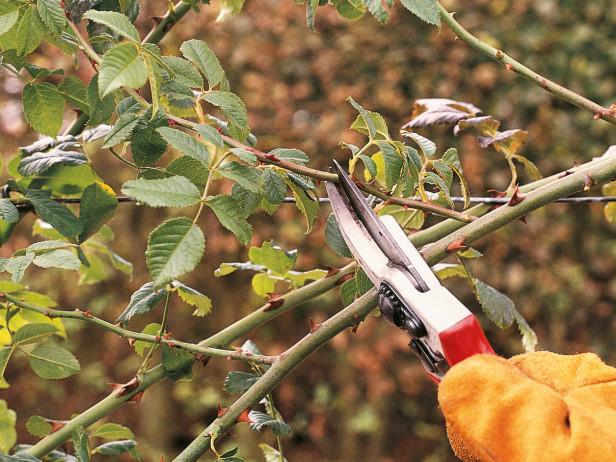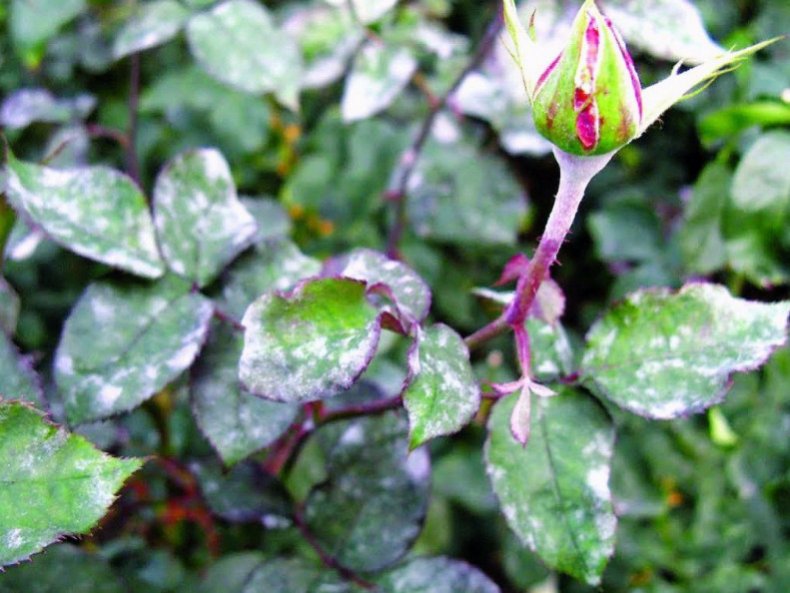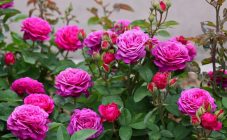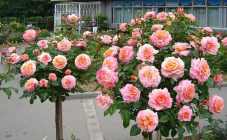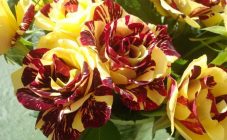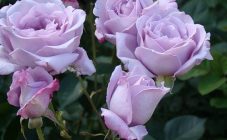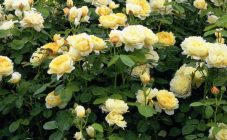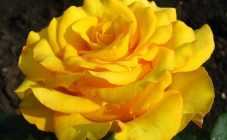Content:
The hybrid tea rose comes from a variety called La France, bred back in 1867. This unusual variety is the result of crossing a tea and a remontant rose. Subsequently, it was possible to bring out about 10 thousand different varieties, each of which has its own differences and characteristics. So, they can differ in the size of the bush and its height, the shape of lovely flowers, as well as color. The hybrid tea rose differs in that its flowers have a very unusual aroma of freshly cut tea, and its flowering is very long, lasting from the first days of summer until late autumn.
Special attention should be paid to the Nostalgia variety - it has rather voluminous flowers that are scattered on the dark green foliage of the bush. This combination looks very advantageous.
Description of the Rose of Nostalgia
The bright color of this variety of roses can draw attention to itself from a distance. If you get closer, you can smell a strong sweet aroma. Relate Nostalgia roses to hybrid tea, most often they can be found in Germany. The rose has large flowers, in shape they resemble a bowl. The petals are slightly twisted, in the middle they are light pink, and closer to the edge they are cherry, sometimes purple. The opening of the buds is rather slow, the flower can stand for a long time and retain its original shade. The edge of the petals is slightly wavy, so the flower looks attractive at any time of blooming.
The plant is not too large, its shoots are strong, stand upright. On average, the height of the bush can reach 80-100 centimeters, and the width is 80 × 50 centimeters. Usually the flowers are 9-11 centimeters in diameter.
The bush of Nostalgia, hybrid tea rose is small, it does not grow too high, it looks quite neat, the foliage is healthy and shiny. The bush can bloom several times, so it is often planted in flower beds.
Rose Nostalgia was bred in 1867 by a French breeder Guyot. Since then, the rose has been named the best variety in competitions throughout Europe many times.
Frost resistance
Rose Nostalgie is a completely winter-hardy variety, it survives a soil temperature of about −23 degrees Celsius, but still gardeners who have been breeding roses for several years advise closing the bushes when frosts begin. The buds can survive long-term rainfall well, the petals are able to retain their shape even after heavy and prolonged rainstorms.
A nostalgic rose can live in central Russia if it is covered during the cold season and planted in places protected from the cold wind.
Planting and yield
The same planting method is used for all hybrid tea varieties. To begin with, determine the right place - with good lighting, there should be no drafts. It is also worth staying away from areas where groundwater flows too high. It is best to dedicate the southeastern part of the garden to roses.
It is desirable that small trees or bushes grow next to the roses. With their help, extra rays of ultraviolet radiation will not get on the roses and drafts will not reach them. The best soil for the Nostalgia rose will be light and loamy. The soil for planting should be warm because hybrid roses cannot tolerate cold soil. The best time for planting is early May. Of course, seedlings can be purchased a little earlier, but then you need to follow all the rules for caring for them.They should be placed in wet sand and taken to a dark, damp place, or placed in the ground and placed on a windowsill.
Before planting a rose, it is worth cutting off its roots and checking the place where the cut was made - it needs to be white inside. Next, the seedlings should be placed in water for half an hour, and only after that they should be planted in the soil.
The roots are placed in the dug small depression, covered with earth, while sometimes shaking the plant so that the soil is denser.
Hilling
So that the lower buds are protected as thoroughly as possible from cold and heat, the plant should be spud. Saplings should never bloom immediately after they are planted in the soil. So, you need to break off the first five buds that appear. This is done so that the root system becomes as strong and strong as possible. The bush can be allowed to bloom fully after its height reaches half a meter.
Pruning
If it so happens that the Nostalgia rose plant is partially extinct or sick, be sure to remove the affected areas so that the infection does not spread further.
In the spring, the stems are cut when the buds are about 8 mm in size. In the summer, they regularly get rid of wilted buds, and in the fall - from shoots that are immature to the end and spoiled.
How to feed
According to the rules, the flowers of the Nostalgic rose need to be fed 3 times: in the spring, so that the bush grows better and gains strength; in summer, so that the plant can adapt well after planting in the soil; and in the fall, so that the bush can accumulate as many nutrients as possible before a long winter. They regularly take time to the bush to feed it with phosphorus, magnesium and potassium.
Bloom
Mass bloom occurs in summer, in June or July and lasts for 31-34 days. Then flowering stops. The second time the rose of Nostalgia begins to delight with beautiful flowers until late autumn.
Diseases and prevention
The most common disease of roses from the class of hybrid tea is powdery mildew. To prevent this from happening, you can use a baking soda solution - 40 grams of soda per 1 liter of water. It is best done in the spring before planting.
Powdery mildew appears on a rose under certain conditions:
- there is a lot of humidity in the air, the weather outside is too cool for the plant, there is a lot of cloudiness, as well as frequent and heavy rains. If the rose is provided with proper care, if it is fed on time and watered regularly, then the risk of disease will significantly decrease;
- there is too much nitrogen in the soil in which the rose was planted;
- non-compliance with the rules in watering. The rose should not be watered very often. Wait until a dry crust forms on the soil surface. This will serve as a signal that the plant needs to "drink". But too rarely, you should not water the bush either.
Aphids can also harm the bush. To provide the rose with protection, you need to treat it with a solution of laundry soap (1 bar of soap per 10 liters of water).
Often the rose can be struck by black spot. The cause of this disease is the mushroom marssonina rosae. It can get into the soil to the rose along with the water that was poured over it, which causes repulsive black spots on the petals.
To overcome such a disease, you need:
- cut off all areas that are affected by the disease. Cut leaves and petals must be burned;
- Treat the bush with drugs that include copper at the frequency indicated in the instructions. Typically, treatment is performed 3-4 times every 7-14 days;
- between treatments, the plants are sprayed around the bush with Fitosporin-M about 3-4 times.
Advantages and disadvantages
Pros of the variety:
- affordability;
- bright and persistent aroma.
Minuses:
- small price in a bouquet;
- small assortment of varieties of this representative.
Rose of Nostalgie is a wonderful variety that will attract attention both with its appearance and attractive aroma. But before you buy a new resident into your house, you first need to carefully study the information about him, weigh the pros and cons, so that you can justify your expectations. If, nevertheless, it is decided to purchase a rose of this variety, the bush, with proper care, will delight both the eye and the sense of smell.


